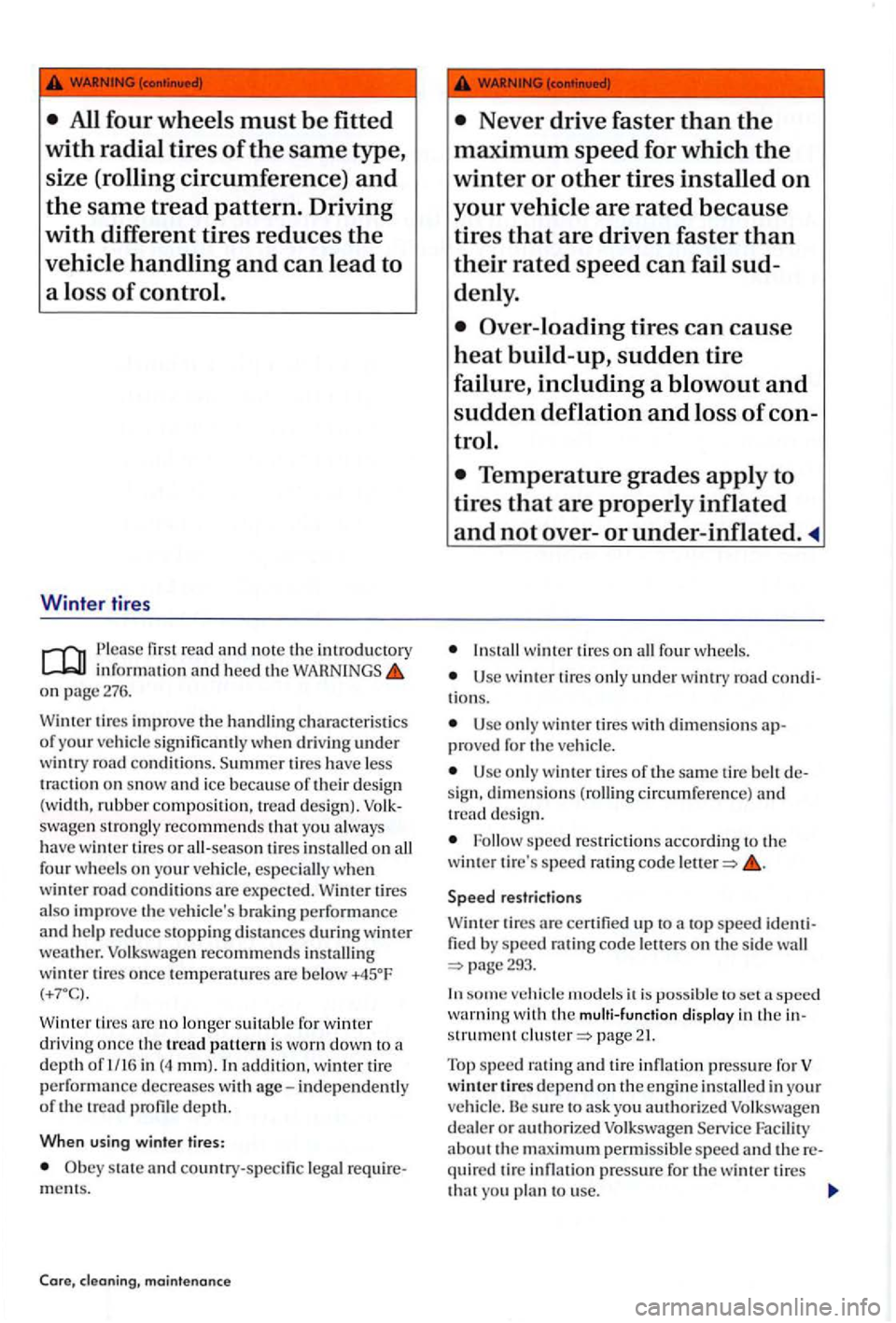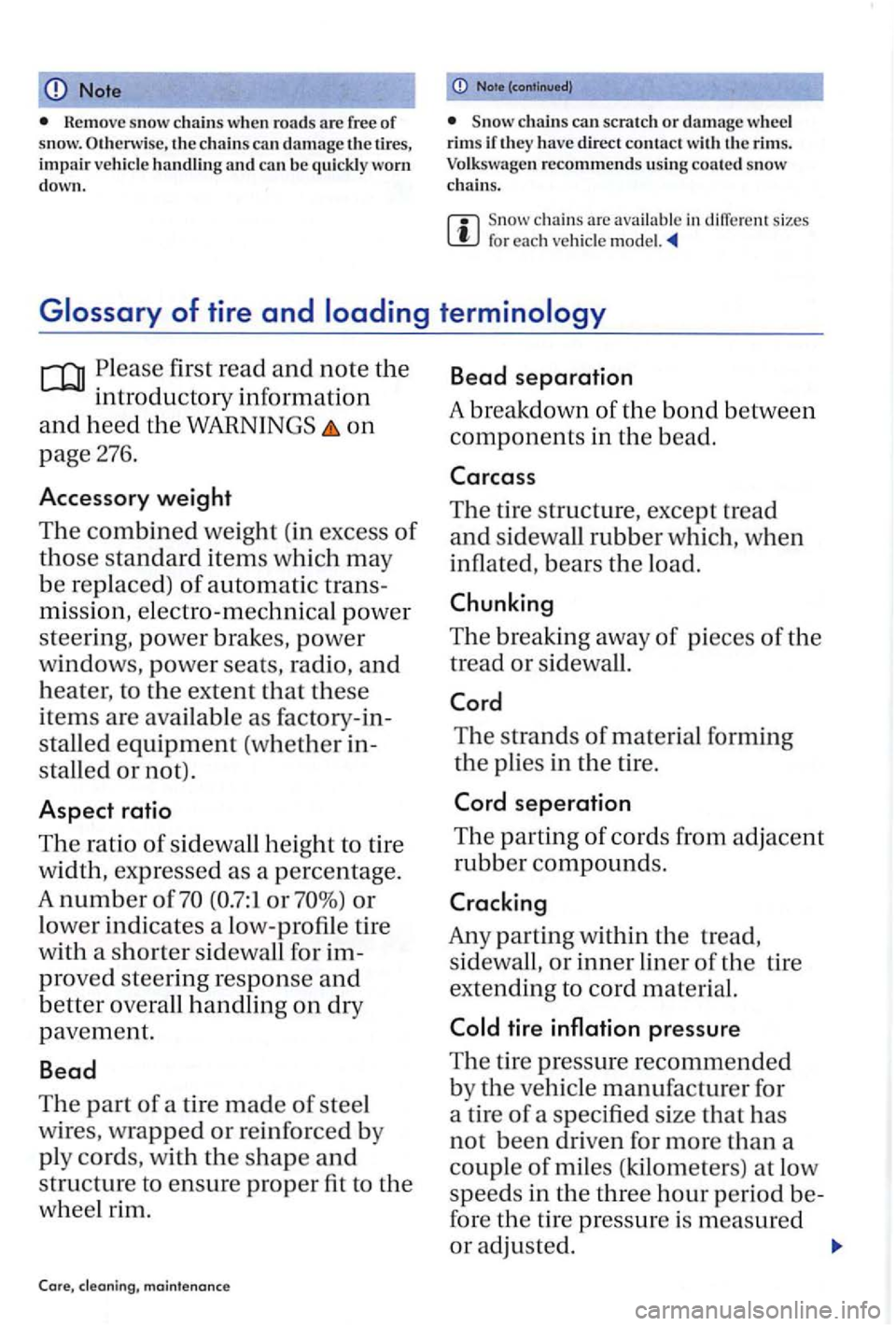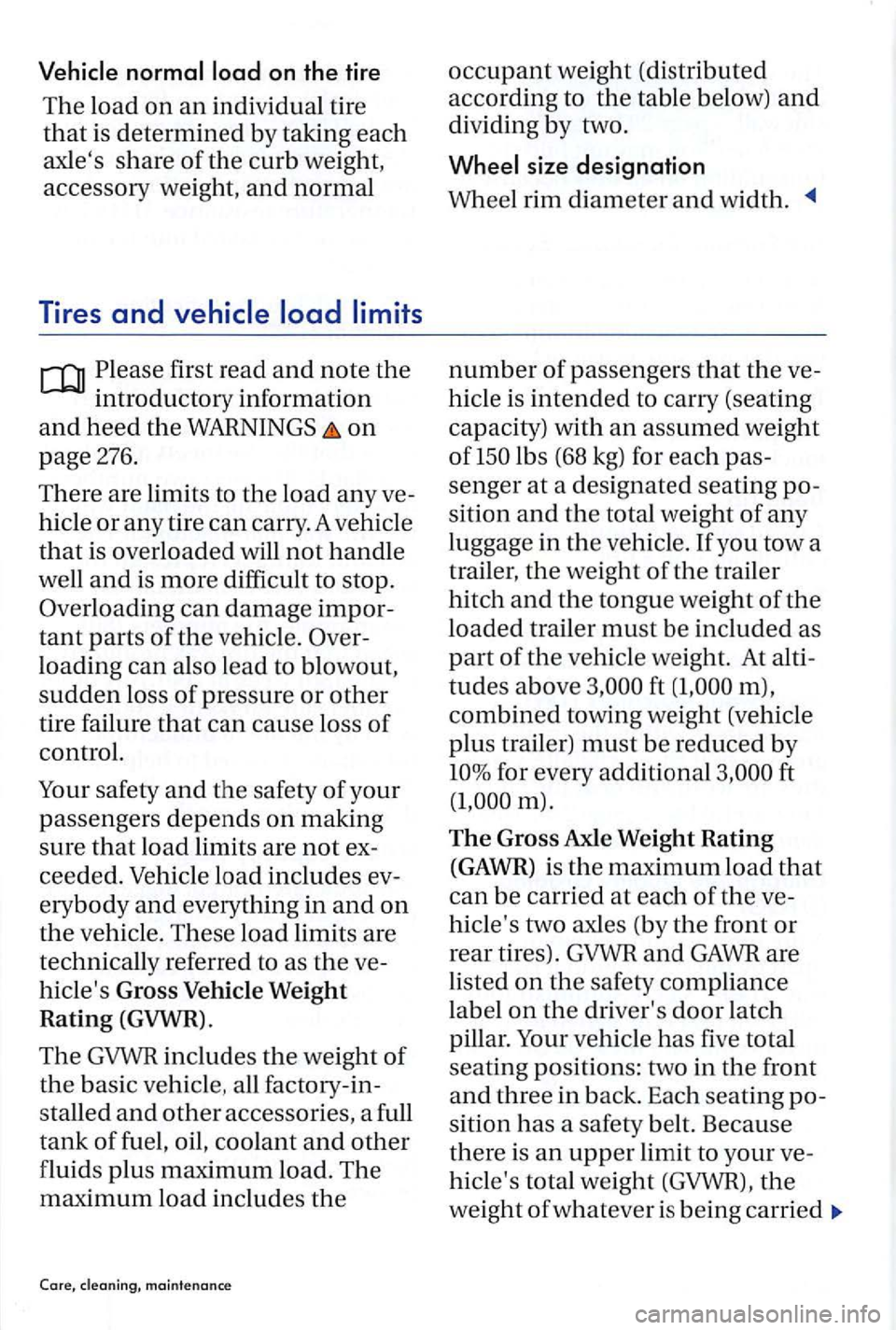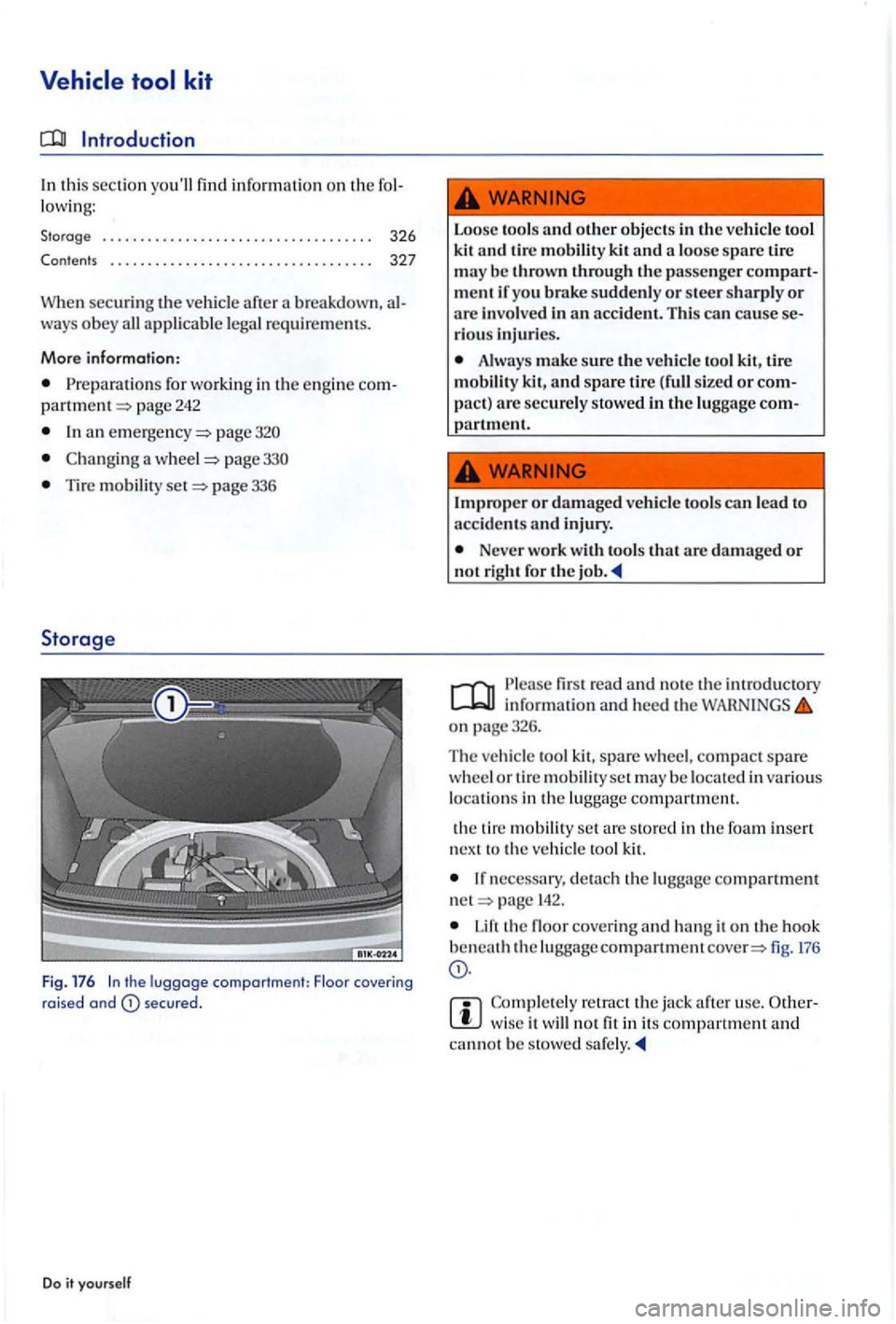2012 VOLKSWAGEN GOLF PLUS tire size
[x] Cancel search: tire sizePage 220 of 541

Each tire, including the spare (if
provided),
should be checked
monthly w hen cold and inflated to
the inflation pressure recom
mended by the vehicle manufac
turer
on the vehicle placard or tire
inflation pressure label.
(If your
vehicle
has tires of a different size
than the size indicated on the ve
hicle placard
or tire inflation pres
sure label, you sho uld determine
the proper tire inflation pressure
for
those tires.)
As an added safety feature, your
vehicle
has been equipped with a
Tire
is not a
substitute for proper tire mainte
nance,
and it is the driver's re
sponsib ility to
maintain correct
tire pressure , even if under-infla
tion
has not reached the level to
trigger illumination
of the
low tire pressure telltale.
Driver assistance systems
Your vehicle has also been
equipped with a malfunc
tion indicator to indicate
when the
system is not operating properly.
The
malfunction indicator is
combined with the low tire pres
sure telltale. When
the system de
tects a malfunction, the telltale
will flash for approximate ly
one
minute and then remain continu
ously illuminated. This sequence
will continue upon subsequent ve
hicle
start-ups as long as the mal
function exists.
When
the malfunction indicator is
illuminated, th e system may not
be able to detect or signal low tire
pressure
as intended.
to continue
to function properly.
Re-setting and reconfirming the
benchmark tire pressure for TPMS
The Reset button for the Tire
sure Monitoring is in the
glove compartment=> page 222,
fig. 142. The Reset button resets the
benchmark tire pressure used by
the
to the current tire pres
sure
in the tires based on the cir
cumference
of the tires. To reset
222 223
Page 291 of 541

All four wheels must be fitted
with radial tires of the same type,
size (rolling circumference)
and
the same tread pattern. Driving
with different tires reduces the
vehicle handling and can lead to
a los s
of control.
Winter tires
informati o n and heed th e on page 276.
W int er tires im
prove the handli ng c ha ra cte ristics of your ve hicle sig nifi cantly whe n driv in g under wintry of their desig n
(w idth, rubber compositi on, tread desig n). swage n stro ng ly recommend s that yo u always
have w int er tires or all-seaso n tires in stalle d on all
four wheels on yo ur ve hicle, especially when
winter road cond itions are ex pected. W inter tires also improve the ve hicle's braking performance an d help reduce stoppin g d is ta nces d uring winter wea ther. Volkswage n recommends in stalli n g
w inter tires o nce temperatures a re below
Wint er tires are no lo nge r suitabl e fo r w inter
dri vin g o nce the tread pattern is worn down to a
d epth o f 1 /16 in (4 mm). In add ition, w inter tir e
p erformance decreases w ith age- ind ependently
o f the tread
sta te country-specific lega l ments.
Core, maint enance
Never drive faster than the
maximum speed for which the
winter or other tires installed on
your vehicle are rated because
tires that are driven faster than
their rated speed can fail sud
denly.
Over-loading tires can cause
heat build-up, sudden tire
failure, including a
blowout and
sudden deflation and loss of con
trol.
Temperature grades apply to
tires
that are properly inflated
and not over-or under-inflated.
w int er tires on all fo ur wheels .
Use w int er tires only under w in try road
Usc only w inter tires w it h dim en sio n s p roved fo r the veh icle.
Usc only win ter tires of the same t ire belt
speed restri ctio ns acco rding to the
winte r tire's speed ra tin g code
restrictions
W in t
er tires cert ifie d up to a top speed fied by speed p age293.
so me vehicle m odels it is possible to se t a s pee d wa rnin g with the multi-function disploy in the page 21.
Top s peed ratin g and tire infl ation press ure fo r
or a uthorized Volk swagen Service about the m aximum permissib le speed a n d quired tir e infl ation press ure for th e winter tires yo u to use.
Page 293 of 541

Note
Remove sno w c hain s w hen road s are free or snow. the chains ca n damage tires, impair vehicle handling and ca n be qui ck ly worn
down.
-------chain s they h ave direct contact w ith th e rims. Volk swage n recommend s usin g coa te d sn ow
chains .
c hain s are available in different sizes
Please first read and note the
introductory information
and heed the WARNINGS on
page 276.
Accessory weight
The combine d weight (in excess of
those standa rd items which may
be re placed) of automatic tra n s
mission, electro-mechnical power
stee ring, power brakes, power
windows, power seats, radio, and
heater, to th e extent that these
items are availabl e as factory-in
stall ed equipme n t (w hether in
s tall ed or not).
Aspect ratio
The ratio of sidewall heig h t to tir e
w
idth, expressed as a p ercentage.
A number o r or
lower indicates a low-profile tire
with a shorter sidewall for im
proved steering response and
better overall handling on dry
pavem ent.
Bead
The part of a tire made of steel
wires, wrapped or reinforced b y
ply cords, with the shape and
structure to en sure proper fit to the
w h
eel rim.
maintenance
Bead separation
A breakdown of the bond between
components in the bead.
The tire structure, excep t tread
and s id ewall rubber which, when
infl ate d, bears the lo ad.
The breakjng away of pieces of the
tread or sidewall.
The strands of materia l forming
the plie s in the tir e.
An y parting within the tread,
s id
ewall, or inne r lin er of the tire
ex te
nding to cord material.
at low
speeds in the three hour p e riod be
fore
the tire pressure is measured
o r a
djuste d.
Page 297 of 541

first read and note the
mtroductory information
and hee d the on
page 276.
There
are limit s to the load any ve
hicl e
or any tire can carry. A vehicle
that is ov erlo ad ed will not h andle
well and is more diffi cult to stop.
Overloading
can d am age impor
tant parts of the ve hicle.
loading can also lead to blowout,
s
udden lo ss of press ure or other
tire failur e that can cause loss of
control.
Your safety and the safety of your
passengers depends on making
sure that load limits are not ex
ceeded. Vehicle load includes ev
e rybody
and everything in and on
the ve hicl e. These load limit s are
technically refe rr
ed to as the ve
hicl
e's Gross Vehicle Weight
Rating (GVWR).
The GVWR includes the weight of
the bas ic vehicle , a ll factory-in
s tall
ed and other accessories, a full
tank of fu el, oil, coo lant and other
fluids
plus m aximum load. The
maximum load includes the
Cor e,
size designation
Wheel rim diamete r and widt h.
number of passengers that the ve
hicl e is
intended to carry (seating
capacity) with an assumed weight
of
ft m),
c
ombine d towin g weight (vehicle
plus trail er) must b e reduced by
for eve ry
Page 323 of 541

Introduction
In thi s section yo u'll find inform ation on th e fo l
l ow ing:
Storage . . . . . . . . . . . . . . . . . . . . . . . . . . . . . . . .
Pr epara tio ns fo r workin g in the eng ine co m
In an p age
a w hee l page
Tire mobili ty page 336
Storage
Fig. 176 In the luggage compartment: Floor covering raised and secu red.
Do it yourse lf
Loose tools and other objects kit and a lo o se spare tire may be thrown through the passenger compart
m ent if yo u brake suddenly or stee r sharply or are involv ed in an accident. This can cause se
r io u s injuri es.
Alw ays make sure the ve hicl e to ol kit , tire
mobili ty kit, and spare tire sized or com
pact ) are securel y stow ed in th e luggage com-ment.
I
mprope r or damaged vehicl e tools can lead to
a ccid ent s and injury .
Neve r work with tools that are damage d or not right for the job .
firs t read and note th e int rod uc tory inform ation an d heed th e o n page326.
T he ve hicle t
ool kit, spare wheel, compact spare w hee l or tir e mobilit y set may be locate d in various
l oca tions in the lu ggage compart men t.
th e tir e m obilit y
set are stored in the foam insert
n ex t to t he ve hicl e too l kit.
If necessary, de ta ch the luggage compartment net page
Lift th e floo r cover ing and ha ng it on th e hook beneath the luggageco mpart mem fig. 176
w ise it not fit in its co mpart ment and ca nnot be stowe d sa fe ly.